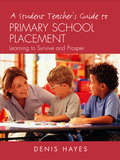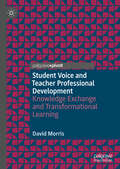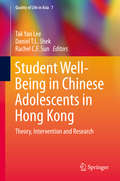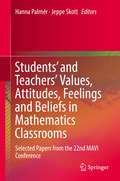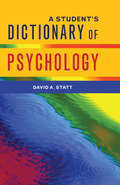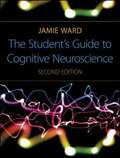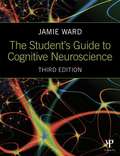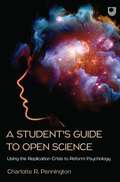- Table View
- List View
A Student Teacher's Guide to Primary School Placement: Learning to Survive and Prosper
by Denis HayesSchool experience is the most significant part of learning to be a teacher. It can also be the most confusing, stressful and challenging. Initially, it can be very daunting to walk into someone else's classroom and try to prepare and teach effective lessons to someone else's class.It helps to have a clear idea of what to expect and to know how other people have coped, and in this book, Denis Hayes looks at what life is like for the student-teacher in the classroom. With plenty of down-to-earth and practical advice, he offers strategies for dealing with challenging situations and positive encouragement to help them succeed. The book covers four main areas: principles - summarises the fundamentals of successful teaching placement - provides detailed advice about preparing for, and prospering in, school placements, including case studies of trainee teachers' experiences practice - looks at practical issues in the classroom, including lesson planning, teaching skills, assessment and evaluation, and managing the classroom environment progress - covers applying for jobs and interview strategies, with newly qualified teachers talking about how they managed in their first few months.This text will be invaluable to anyone training to be a primary teacher and about to embark on his or her teaching experience. It will also be a useful resource for teacher mentors and course leaders of BEd, BA (Ed) and PGCE programmes.
Student Voice and Teacher Professional Development: Knowledge Exchange and Transformational Learning
by David MorrisThis book explores the role of students’ involvement in teacher professional development. Building upon a research study whereby pupils instruct their teachers in the use of Information and Communication Technology (ICT), the author argues that using student voice in this way can result in transformational learning for all those involved. The author presents the processes and experiences of pupils taking on the role of educators as well as the experiences of the teachers receiving such professional development from their students. In doing so, he promotes the innovative use of a student voice initiative to support teaching and learning, with the overarching purpose of improving and transforming teacher-pupil relationships. This book will be of interest and value to students and scholars of pupil voice, teacher professional development and transformational learning.
Student Well-Being in Chinese Adolescents in Hong Kong: Theory, Intervention and Research (Quality of Life in Asia #7)
by Tak Yan Lee Daniel T.L. Shek Rachel C. F. SunThis book reviews the theories regarding commonly occurring developmental issues among Chinese adolescents in Hong Kong, the application of Positive Youth Development (PYD) to a large-scale primary prevention program and the impact of PYD on student well-being, indexed according to adolescent developmental issue. Using multiple strategies, it presents the overall constructs and frameworks supporting P.A.T.H.S. in response to the various psychosocial needs of Hong Kong’s youth. Some of the issues covered include substance abuse, sexual behavior, internet addiction, bullying and cyber-bullying. The book argues for the effectiveness of the school-based program in promoting student well-being in modern Hong Kong society and will be of interest to undergraduate and postgraduate students, university instructors, researchers, social workers, pediatricians, youth workers, educators, administrators, psychologists, school principals and allied professionals looking to promote whole-person development in junior form students and especially those with an interest in education in China.
Students' and Teachers' Values, Attitudes, Feelings and Beliefs in Mathematics Classrooms: Selected Papers from the 22nd MAVI Conference
by Hanna Palmér Jeppe SkottThis contributed volume is an exciting product of the 22nd MAVI conference, which presents cutting-edge research on affective issues in teaching and learning math. The teaching and learning of mathematics is highly dependent on students’ and teachers’ values, attitudes, feelings, beliefs and motivations towards mathematics and mathematics education. These peer-reviewed contributions provide critical insights through their theoretically and methodologically diverse analyses of relevant issues related to affective factors in teaching and learning math and offer new tools and strategies by which to evaluate affective factors in students’ and teachers’ mathematical activities in the classroom. Among the topics discussed: The relationship between proxies for learning and mathematically related beliefs.Teaching for entrepreneurial and mathematical competences.Prospective teachers’ conceptions of the concepts mean, median, and mode.Prospective teachers’ approach to reasoning and proofThe impact of assessment on students’ experiences of mathematics. Through its thematic connections to teacher education, professional development, assessment, entrepreneurial competences, and reasoning and proof, Students' and Teachers' Values, Attitudes, Feelings and Beliefs in Mathematics Classrooms proves to be a valuable resource for educators, practitioners, and students for applications at primary, secondary, and university levels.
A Student's Dictionary of Psychology
by David A. StattA Student's Concise Dictionary of Psychology contains over 1900 definitions from ablation to zygote. There are references to words, phrases and eminent psychological figures and David A. Statt has taken into account the most recent developments in psychology to present the definitions in a clear, instructive and concise manner.This book will be an invaluable source of information for students of psychology and its easily accessible style will make it an indispensable reference tool for those in related professions such as health and social work.
A Student's Dictionary of Psychology
by David A. StattA Student's Concise Dictionary of Psychology contains over 1900 definitions from ablation to zygote. There are references to words, phrases and eminent psychological figures and David A. Statt has taken into account the most recent developments in psychology to present the definitions in a clear, instructive and concise manner.This book will be an invaluable source of information for students of psychology and its easily accessible style will make it an indispensable reference tool for those in related professions such as health and social work.
A Student's Dictionary of Psychology and Neuroscience
by Dr Nicky Hayes Peter StrattonThis is the essential reference work for any student studying psychology for the first time. Packed with easy-to-understand definitions and helpful diagrams, the new edition has been expanded to include the key concepts within the growing field of neuroscience, as well as greater coverage of positive psychology. Key features include: over 2,500 entries extensive cross-referencing for easy navigation mini biographies of key psychologists list of key reference works study notes section list of common abbreviations Also including a list of key references in the field and a guide to writing essays and referencing your work, this is the perfect accompaniment for any student newly encountering this fascinating subject, those taking related disciplines in the health or social sciences, or professionals wanting to familiarise themselves with key terms and ideas.
A Student's Dictionary of Psychology and Neuroscience
by Nicky Hayes Peter StrattonAn essential reference work for any student studying psychology for the first time, A Student's Dictionary of Psychology and Neuroscience (Seventh Edition) provides over 2,500 definitions of complex concepts in clear and accessible language alongside helpful diagrams. The dictionary offers comprehensive coverage of the main contemporary terms in psychology and neuroscience. This new edition features updated references which will be particularly relevant to the key areas of neuroscience and neuropsychology and also to recent concepts of psychological significance, such as expanded coverage of research methods, internet psychology, cognitive psychology and social psychology. The dictionary also features end material with useful notes for constructing student essays as well as key references and a list of common abbreviations. Extensive cross-referencing allows students to follow up and identify further details of a given topic, and mini-biographies of key psychologists help to provide relevant context. A Student's Dictionary of Psychology and Neuroscience is the perfect accompaniment for any student newly encountering this fascinating subject, those taking related disciplines in the health or social sciences, or professionals wanting to familiarise themselves with key terms and ideas.
A Student's Dictionary of Psychology and Neuroscience
by Nicky Hayes Peter StrattonAn essential reference work for any student studying psychology for the first time, A Student's Dictionary of Psychology and Neuroscience (Seventh Edition) provides over 2,500 definitions of complex concepts in clear and accessible language alongside helpful diagrams. The dictionary offers comprehensive coverage of the main contemporary terms in psychology and neuroscience. This new edition features updated references which will be particularly relevant to the key areas of neuroscience and neuropsychology and also to recent concepts of psychological significance, such as expanded coverage of research methods, internet psychology, cognitive psychology and social psychology. The dictionary also features end material with useful notes for constructing student essays as well as key references and a list of common abbreviations. Extensive cross-referencing allows students to follow up and identify further details of a given topic, and mini-biographies of key psychologists help to provide relevant context. A Student's Dictionary of Psychology and Neuroscience is the perfect accompaniment for any student newly encountering this fascinating subject, those taking related disciplines in the health or social sciences, or professionals wanting to familiarise themselves with key terms and ideas.
A Student's Guide to Analysis of Variance
by Maxwell Roberts Riccardo RussoIn the investigation of human behaviour, statistical techniques are employed widely in the social sciences. Whilst introductory statistics courses cover essential techniques, the complexities of behaviour demand that more flexible and comprehensive methods are also employed. Analysis of Variance (ANOVA) has become one of the most common of these and it is therefore essential for both student and researcher to have a thorough understanding of it.A Student's Guide to Analysis of Variance covers a range of statistical techniques associated with ANOVA, including single and multiple factor designs, various follow-up procedures such as post-hoc tests, and how to make sense of interactions. Suggestions on the best use of techniques and advice on how to avoid the pitfalls are included, along with guidelines on the writing of formal reports.Introductory level topics such as standard deviation, standard error and t-tests are revised, making this book an invaluable aid to all students for whom ANOVA is a compulsory topic. It will also serve as a useful refresher for the more advanced student and practising researcher.
A Student's Guide to Analysis of Variance
by Maxwell Roberts Riccardo RussoIn the investigation of human behaviour, statistical techniques are employed widely in the social sciences. Whilst introductory statistics courses cover essential techniques, the complexities of behaviour demand that more flexible and comprehensive methods are also employed. Analysis of Variance (ANOVA) has become one of the most common of these and it is therefore essential for both student and researcher to have a thorough understanding of it.A Student's Guide to Analysis of Variance covers a range of statistical techniques associated with ANOVA, including single and multiple factor designs, various follow-up procedures such as post-hoc tests, and how to make sense of interactions. Suggestions on the best use of techniques and advice on how to avoid the pitfalls are included, along with guidelines on the writing of formal reports.Introductory level topics such as standard deviation, standard error and t-tests are revised, making this book an invaluable aid to all students for whom ANOVA is a compulsory topic. It will also serve as a useful refresher for the more advanced student and practising researcher.
A Student′s Guide to Cognitive Neuropsychology
by Ashok JansariAre all brains the same? What causes amnesia? And why did a man mistake his psychologist for George Michael? Find out the answers to these questions, and much more, in A Student′s Guide to Cognitive Neuropsychology. Written in an informative and accessible style, this comprehensive text guides you through the traditional areas of cognitive neuropsychology and beyond, applying core theoretical principles to real-world scenarios. Covering topics from memory to facial recognition, and from language to neglect, this textbook is essential reading for any student of cognitive neuropsychology. A Student′s Guide to Cognitive Neuropsychology also includes features to help enhance your understanding of cognitive neuropsychology, such as: Important researcher spotlights Key research studies Questions for reflection Further reading Ashok Jansari is Senior Lecturer in Cognitive Neuropsychology at Goldsmiths, University of London.
A Student′s Guide to Cognitive Neuropsychology
by Ashok JansariAre all brains the same? What causes amnesia? And why did a man mistake his psychologist for George Michael? Find out the answers to these questions, and much more, in A Student′s Guide to Cognitive Neuropsychology. Written in an informative and accessible style, this comprehensive text guides you through the traditional areas of cognitive neuropsychology and beyond, applying core theoretical principles to real-world scenarios. Covering topics from memory to facial recognition, and from language to neglect, this textbook is essential reading for any student of cognitive neuropsychology. A Student′s Guide to Cognitive Neuropsychology also includes features to help enhance your understanding of cognitive neuropsychology, such as: Important researcher spotlights Key research studies Questions for reflection Further reading Ashok Jansari is Senior Lecturer in Cognitive Neuropsychology at Goldsmiths, University of London.
A Student′s Guide to Cognitive Neuropsychology
by Ashok JansariAre all brains the same? What causes amnesia? And why did a man mistake his psychologist for George Michael? Find out the answers to these questions, and much more, in A Student′s Guide to Cognitive Neuropsychology. Written in an informative and accessible style, this comprehensive text guides you through the traditional areas of cognitive neuropsychology and beyond, applying core theoretical principles to real-world scenarios. Covering topics from memory to facial recognition, and from language to neglect, this textbook is essential reading for any student of cognitive neuropsychology. A Student′s Guide to Cognitive Neuropsychology also includes features to help enhance your understanding of cognitive neuropsychology, such as: Important researcher spotlights Key research studies Questions for reflection Further reading Ashok Jansari is Senior Lecturer in Cognitive Neuropsychology at Goldsmiths, University of London.
The Student's Guide to Cognitive Neuroscience
by Jamie WardReflecting recent changes in the way cognition and the brain are studied, this thoroughly updated third edition of the best-selling textbook provides a comprehensive and student-friendly guide to cognitive neuroscience. Jamie Ward provides an easy-to-follow introduction to neural structure and function, as well as all the key methods and procedures of cognitive neuroscience, with a view to helping students understand how they can be used to shed light on the neural basis of cognition. The book presents an up-to-date overview of the latest theories and findings in all the key topics in cognitive neuroscience, including vision, memory, speech and language, hearing, numeracy, executive function, social and emotional behaviour and developmental neuroscience, as well as a new chapter on attention. Throughout, case studies, newspaper reports and everyday examples are used to help students understand the more challenging ideas that underpin the subject. In addition each chapter includes: Summaries of key terms and points Example essay questions Recommended further reading Feature boxes exploring interesting and popular questions and their implications for the subject. Written in an engaging style by a leading researcher in the field, and presented in full-color including numerous illustrative materials, this book will be invaluable as a core text for undergraduate modules in cognitive neuroscience. It can also be used as a key text on courses in cognition, cognitive neuropsychology, biopsychology or brain and behavior. Those embarking on research will find it an invaluable starting point and reference. The Student’s Guide to Cognitive Neuroscience, 3rd Edition is supported by a companion website, featuring helpful resources for both students and instructors.
The Student's Guide to Cognitive Neuroscience
by Jamie WardReflecting recent changes in the way cognition and the brain are studied, this thoroughly updated third edition of the best-selling textbook provides a comprehensive and student-friendly guide to cognitive neuroscience. Jamie Ward provides an easy-to-follow introduction to neural structure and function, as well as all the key methods and procedures of cognitive neuroscience, with a view to helping students understand how they can be used to shed light on the neural basis of cognition. The book presents an up-to-date overview of the latest theories and findings in all the key topics in cognitive neuroscience, including vision, memory, speech and language, hearing, numeracy, executive function, social and emotional behaviour and developmental neuroscience, as well as a new chapter on attention. Throughout, case studies, newspaper reports and everyday examples are used to help students understand the more challenging ideas that underpin the subject. In addition each chapter includes: Summaries of key terms and points Example essay questions Recommended further reading Feature boxes exploring interesting and popular questions and their implications for the subject. Written in an engaging style by a leading researcher in the field, and presented in full-color including numerous illustrative materials, this book will be invaluable as a core text for undergraduate modules in cognitive neuroscience. It can also be used as a key text on courses in cognition, cognitive neuropsychology, biopsychology or brain and behavior. Those embarking on research will find it an invaluable starting point and reference. The Student’s Guide to Cognitive Neuroscience, 3rd Edition is supported by a companion website, featuring helpful resources for both students and instructors.
The Student's Guide to Cognitive Neuroscience
by Jamie WardReflecting recent changes in the way cognition and the brain are studied, this thoroughly updated fourth edition of this bestselling textbook provides a comprehensive and student-friendly guide to cognitive neuroscience. Jamie Ward provides an easy-to-follow introduction to neural structure and function, as well as all the key methods and procedures of cognitive neuroscience, with a view to helping students understand how they can be used to shed light on the neural basis of cognition. The book presents a comprehensive overview of the latest theories and findings in all the key topics in cognitive neuroscience, including vision, hearing, attention, memory, speech and language, numeracy, executive function, social and emotional behavior and developmental neuroscience. Throughout, case studies, newspaper reports, everyday examples and studentfriendly pedagogy are used to help students understand the more challenging ideas that underpin the subject. New to this edition: Increased focus on the impact of genetics on cognition New coverage of the cutting-edge field of connectomics Coverage of the latest research tools including tES and fNIRS and new methodologies such as multi-voxel pattern analysis in fMRI research Additional content is also included on network versus modular approaches, brain mechanisms of hand-eye coordination, neurobiological models of speech perception and production and recent models of anterior cingulate function. Written in an engaging style by a leading researcher in the field and presented in full color including numerous illustrative materials, this book will be invaluable as a core text for undergraduate modules in cognitive neuroscience. It can also be used as a key text on courses in cognition, cognitive neuropsychology, biopsychology or brain and behavior. Those embarking on research will find it an invaluable starting point and reference. This textbook is supported by an extensive companion website for students and instructors, including lectures by leading researchers, links to key studies and interviews, interactive multiple-choice questions and flashcards of key terms.
The Student's Guide to Cognitive Neuroscience
by Jamie WardReflecting recent changes in the way cognition and the brain are studied, this thoroughly updated fourth edition of this bestselling textbook provides a comprehensive and student-friendly guide to cognitive neuroscience. Jamie Ward provides an easy-to-follow introduction to neural structure and function, as well as all the key methods and procedures of cognitive neuroscience, with a view to helping students understand how they can be used to shed light on the neural basis of cognition. The book presents a comprehensive overview of the latest theories and findings in all the key topics in cognitive neuroscience, including vision, hearing, attention, memory, speech and language, numeracy, executive function, social and emotional behavior and developmental neuroscience. Throughout, case studies, newspaper reports, everyday examples and studentfriendly pedagogy are used to help students understand the more challenging ideas that underpin the subject. New to this edition: Increased focus on the impact of genetics on cognition New coverage of the cutting-edge field of connectomics Coverage of the latest research tools including tES and fNIRS and new methodologies such as multi-voxel pattern analysis in fMRI research Additional content is also included on network versus modular approaches, brain mechanisms of hand-eye coordination, neurobiological models of speech perception and production and recent models of anterior cingulate function. Written in an engaging style by a leading researcher in the field and presented in full color including numerous illustrative materials, this book will be invaluable as a core text for undergraduate modules in cognitive neuroscience. It can also be used as a key text on courses in cognition, cognitive neuropsychology, biopsychology or brain and behavior. Those embarking on research will find it an invaluable starting point and reference. This textbook is supported by an extensive companion website for students and instructors, including lectures by leading researchers, links to key studies and interviews, interactive multiple-choice questions and flashcards of key terms.
The Student's Guide to Cognitive Neuroscience (2nd edition)
by Jamie WardReflecting recent changes in the way cognition and the brain are studied, this updated edition provides a comprehensive and student-friendly guide to cognitive neuroscience. Jamie Ward provides an easy-to-follow introduction to neural structure and function, as well as all the key methods and procedures of cognitive neuroscience, with a view to helping students understand how they can be used to shed light on the neural basis of cognition. The book presents an up-to-date overview of the latest theories and findings in all the key topics in cognitive neuroscience, including vision, attention, memory, speech and language, numeracy, executive function, and social and emotional behavior. This edition also contains two completely new chapters on developmental cognitive neuroscience and hearing Throughout, case studies, newspaper reports and everyday examples are used to help students understand the more challenging ideas that underpin the subject. In addition each chapter includes: Summaries of key terms and points Example essay questions Recommended further reading Feature boxes exploring interesting and popular questions and their implications for the subject
The Student's Guide to Cognitive Neuroscience (2nd edition) (PDF)
by Jamie WardReflecting recent changes in the way cognition and the brain are studied, this updated edition provides a comprehensive and student-friendly guide to cognitive neuroscience. Jamie Ward provides an easy-to-follow introduction to neural structure and function, as well as all the key methods and procedures of cognitive neuroscience, with a view to helping students understand how they can be used to shed light on the neural basis of cognition. The book presents an up-to-date overview of the latest theories and findings in all the key topics in cognitive neuroscience, including vision, attention, memory, speech and language, numeracy, executive function, and social and emotional behavior. This edition also contains two completely new chapters on developmental cognitive neuroscience and hearing Throughout, case studies, newspaper reports and everyday examples are used to help students understand the more challenging ideas that underpin the subject. In addition each chapter includes: Summaries of key terms and points Example essay questions Recommended further reading Feature boxes exploring interesting and popular questions and their implications for the subject
The Student's Guide to Cognitive Neuroscience (3rd edition) (PDF)
by Jamie WardReflecting recent changes in the way cognition and the brain are studied, this thoroughly updated third edition of the best-selling textbook provides a comprehensive and student-friendly guide to cognitive neuroscience. Jamie Ward provides an easy-to-follow introduction to neural structure and function, as well as all the key methods and procedures of cognitive neuroscience, with a view to helping students understand how they can be used to shed light on the neural basis of cognition. The book presents an up-to-date overview of the latest theories and findings in all the key topics in cognitive neuroscience, including vision, memory, speech and language, hearing, numeracy, executive function, social and emotional behaviour and developmental neuroscience, as well as a new chapter on attention. Throughout, case studies, newspaper reports and everyday examples are used to help students understand the more challenging ideas that underpin the subject. In addition each chapter includes: Summaries of key terms and points Example essay questions Recommended further reading Feature boxes exploring interesting and popular questions and their implications for the subject. Written in an engaging style by a leading researcher in the field, and presented in full-color including numerous illustrative materials, this book will be invaluable as a core text for undergraduate modules in cognitive neuroscience. It can also be used as a key text on courses in cognition, cognitive neuropsychology, biopsychology or brain and behavior. Those embarking on research will find it an invaluable starting point and reference. The Student's Guide to Cognitive Neuroscience, 3rd Edition is supported by a companion website, featuring helpful resources for both students and instructors.
A Student's Guide to Developmental Psychology
by Margaret Harris Gert WestermannThis major new undergraduate textbook provides students with everything they need when studying developmental psychology. Guiding students through the key topics, the book provides both an overview of traditional research and theory as well as an insight into the latest research findings and techniques. Taking a chronological approach, the key milestones from birth to adolescence are highlighted and clear links between changes in behaviour and developments in brain activity are made. Each chapter also highlights both typical and atypical developments, as well as discussing and contrasting the effects of genetic and environmental factors. The book contains a wealth of pedagogical features to help students engage with the material, including: Learning objectives for every chapter Key term definitions Over 100 colour illustrations Chapter summaries Further reading Suggested essay questions. A Student’s Guide to Developmental Psychology is supported by a companion website, featuring a range of helpful supplementary resources including exclusive video clips to illustrate key developmental concepts. This book is essential reading for all undergraduate students of developmental psychology. It will also be of interest to those in education, healthcare and other subjects requiring an up-to-date and accessible overview of child development.
A Student's Guide to Developmental Psychology
by Margaret Harris Gert WestermannThis major new undergraduate textbook provides students with everything they need when studying developmental psychology. Guiding students through the key topics, the book provides both an overview of traditional research and theory as well as an insight into the latest research findings and techniques. Taking a chronological approach, the key milestones from birth to adolescence are highlighted and clear links between changes in behaviour and developments in brain activity are made. Each chapter also highlights both typical and atypical developments, as well as discussing and contrasting the effects of genetic and environmental factors. The book contains a wealth of pedagogical features to help students engage with the material, including: Learning objectives for every chapter Key term definitions Over 100 colour illustrations Chapter summaries Further reading Suggested essay questions. A Student’s Guide to Developmental Psychology is supported by a companion website, featuring a range of helpful supplementary resources including exclusive video clips to illustrate key developmental concepts. This book is essential reading for all undergraduate students of developmental psychology. It will also be of interest to those in education, healthcare and other subjects requiring an up-to-date and accessible overview of child development.
A Student's Guide to Open Science: Using the Replication Crisis to Reform Psychology
by Charlotte Pennington“Dr Charlotte R. Pennington has pulled off a remarkable trifecta of being clear, concise, and comprehensive in covering the origins of the open science movement and practical advice for adopting the behaviors”Professor Brian Nosek, Executive Director, Center for Open Science; University of Virginia, US''I believe this book will be extremely valuable to both students and academics who wish to further their understanding of transparent research in psychology, and I have already taken steps towards adding this as a core text in my department!'' Psychology Teaching Review“My hope is that every psychology student will finish their degree with a heavily annotated, well-thumbed copy of this important and timely book!”Dr Madeleine Pownall, University of Leeds, UK“This book should be on the reading list for all university science degrees and on all library bookshelves. It is concise, accessible, and remarkably interactive, with brilliant use of examples and learning activities. Is there a better instruction manual on how to do science properly? If there is, I haven’t seen it.”Professor Chris Chambers, Cardiff University, UK“This book will equip future generations with the tools necessary to improve our disciplines, and thereby represents a significant ray of hope for the future. Essential and timely.”Dr Emma Henderson, University of Surrey, UK A Student’s Guide to Open Science explores the so-called “replication crisis” in psychology (the inherent difficulties in replicating or reproducing research results to test the robustness of findings) while delving into the ways that open science can address the crisis by transforming research practice.Students will develop a fundamental understanding of the origins and drivers of the crisis and learn how open science practices can enhance research transparency, replication, and reproducibility.With a handy, digestible guide for students and researchers alike on how to implement open science practices within their own workflow, as well as pedagogic teaching and learning activities that can be re-used by educators, Pennington’s new book is an essential guide to navigating the replication crisis.Key features of this book include:• An overview of landmark events that will mark the history of the replication crisis.• Case studies of classic psychological studies undergoing replication.• Test yourself activities to reinforce learning of key concepts, including an open science crossword!• Top tips for adopting open science practices, including study preregistration, Registered Reports, and open materials, code, and data.• Useful illustrations to aid understanding and facilitate revision. New concepts and practices can often feel overwhelming, but this book aims to help students and educators pick what they want from the ‘open science buffet’ and return to the table to fill up their plates again and again. Remember, we are all students of open science and will be for many years to come!Dr Charlotte R. Pennington is a Lecturer in Psychology at Aston University, Birmingham, UK and a Fellow of the Higher Education Academy. She is an expert in open science and advocates for the teaching of this within higher education pedagogy.
A Students' Guide to Piaget
by D. G. BoyleA Students' Guide to Piaget is a students' guide to the work of Jean Piaget, one of the most influential thinkers in contemporary psychology. It discusses Piaget's multifarious epistemological interests, his developmental psychology, and his solutions to the problems of mathematical epistemology. Piaget's contributions to education, as well as his early work on children's language and cognitive development, are also examined. This book is comprised of 10 chapters and begins with an overview of the major problem that confronts students when they first encounter Piaget's work: why he has done it. Piaget's attempt to answer some very important questions in the branch of philosophy called epistemology is also considered. The next chapter introduces the reader to the basic concepts of Piaget's psychology and his concern with the development of intelligence. The discussion then turns to his views about the sensorimotor phase, pre-operational thinking, and operational thinking in children. A brief summary of developmental periods in Piaget's psychology is presented, and his solutions to the problems of mathematical epistemology are outlined. The remaining chapters focus on Piaget's preoccupation with genetic epistemology, his contributions to education, and his work on children's language and cognitive development. The final chapter analyzes some of the objections that have been raised or may be raised to Piaget's work. This monograph will be a useful resource for psychology students.
